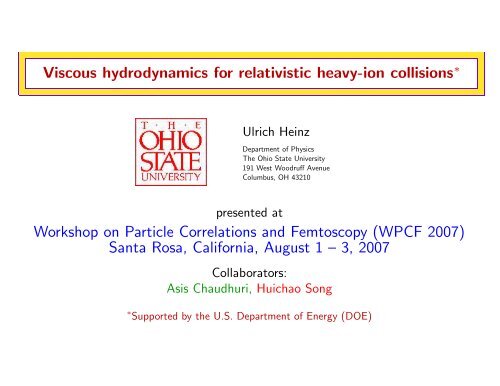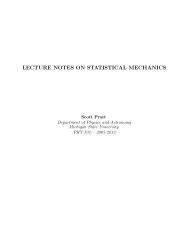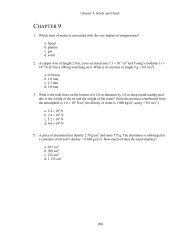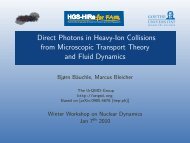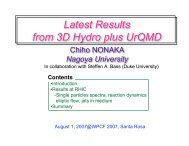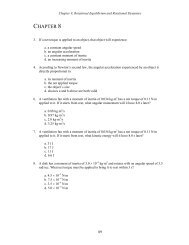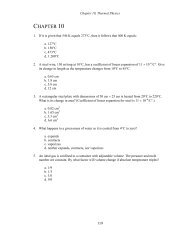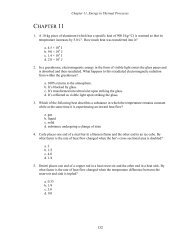Viscous hydrodynamics for relativistic heavy-ion collisions ...
Viscous hydrodynamics for relativistic heavy-ion collisions ...
Viscous hydrodynamics for relativistic heavy-ion collisions ...
You also want an ePaper? Increase the reach of your titles
YUMPU automatically turns print PDFs into web optimized ePapers that Google loves.
<strong>Viscous</strong> <strong>hydrodynamics</strong> <strong>for</strong> <strong>relativistic</strong> <strong>heavy</strong>-<strong>ion</strong> collis<strong>ion</strong>s ∗<br />
Ulrich Heinz<br />
Department of Physics<br />
The Ohio State University<br />
191 West Woodruff Avenue<br />
Columbus, OH 43210<br />
presented at<br />
Workshop on Particle Correlat<strong>ion</strong>s and Femtoscopy (WPCF 2007)<br />
Santa Rosa, Cali<strong>for</strong>nia, August 1 – 3, 2007<br />
Collaborators:<br />
Asis Chaudhuri, Huichao Song<br />
∗ Supported by the U.S. Department of Energy (DOE)
Collective flow tests the Equat<strong>ion</strong> of State:<br />
Hydrodynamic equat<strong>ion</strong>s, ideal fluid limit:<br />
( ˙ f = time derivative in local rest frame, ∂·u = local expans<strong>ion</strong> rate)<br />
ṅ B = −n B (∂·u)<br />
˙ε = −(ε + p) (∂·u)<br />
˙u µ = ∇µ p<br />
ε + p =<br />
c2 s<br />
1+c 2 s<br />
∇ µ ε<br />
ε<br />
• flow driven by pressure gradients ∇ µ p<br />
• accelerat<strong>ion</strong> ∇µ p<br />
ε+p<br />
speed of sound c 2 s = ∂p<br />
∂ε<br />
closely related to<br />
Karsch+Laermann, hep-lat/0305025<br />
0.40<br />
2<br />
0.35 v s =dp/dε<br />
Chojnacki et al., nucl-th/0410036<br />
0.30<br />
0.25<br />
0.20<br />
0.15<br />
0.10<br />
n f =2, m=0.65<br />
n f =2, m=0.75<br />
n f =2, m=0.85<br />
n f =2, m=0.95<br />
SU(3)<br />
0.05<br />
T / T c<br />
0.00<br />
0.0 0.5 1.0 1.5 2.0 2.5 3.0 3.5 4.0<br />
“Softest point” near T = T cr .<br />
Ulrich Heinz <strong>Viscous</strong> <strong>hydrodynamics</strong> (WPCF, 08/01/2007) 1(26)
Successes of <strong>hydrodynamics</strong> at RHIC:<br />
1/ 2π dN/dyp T<br />
dp T<br />
(GeV −2 )<br />
1/2π dN/dyp T<br />
dp T<br />
(GeV −2 )<br />
Single particle spectra from central and peripheral<br />
Au+Au @ 130 A GeV (STAR, PHENIX):<br />
π + PHENIX<br />
10 2 p PHENIX<br />
p STAR<br />
π + hydro<br />
10 0<br />
p hydro<br />
10 −2<br />
most central<br />
0 1 2 3<br />
p (GeV) T<br />
10 0 PHENIX<br />
STAR<br />
hydro<br />
10 −2<br />
10 −4<br />
10 −6<br />
10 −8<br />
p<br />
60 − 92 %<br />
centrality<br />
0 − 5 %<br />
5 − 15 %<br />
15 − 30 %<br />
30 − 60 %<br />
0 1 2 3 4<br />
p (GeV) T<br />
1/2π dN/dyp T<br />
dp T<br />
(GeV −2 )<br />
1/2π dN/dyp T<br />
dp T<br />
(GeV −2 )<br />
PHENIX<br />
10 2 STAR<br />
hydro<br />
10 0<br />
centrality<br />
0 − 5 %<br />
10 −2<br />
5 − 15 %<br />
15 − 30 %<br />
10 −4<br />
30 − 60 %<br />
10 −6<br />
π − 60 − 92 %<br />
0 0.5 1 1.5 2 2.5<br />
p (GeV) T<br />
0 − 5 %<br />
PHENIX<br />
hydro<br />
10 0 5 − 15 %<br />
10 −2<br />
15 − 30 %<br />
30 − 60 %<br />
10 −4<br />
60 − 92 %<br />
centrality<br />
10 −6<br />
K +<br />
0 0.5 1 1.5 2<br />
p (GeV) T<br />
Model parameters fixed with π, ¯p spectra at b = 0;<br />
all other spectra predicted (UH & P.Kolb, hep-ph/0204061).<br />
v 2<br />
(%)<br />
v 2<br />
(%)<br />
Centrality and momentum<br />
dependence of elliptic flow v 2<br />
(STAR, PHENIX, PHOBOS):<br />
10<br />
8<br />
6<br />
4<br />
25<br />
20<br />
15<br />
10<br />
eWN<br />
sWN<br />
eBC<br />
sBC<br />
STAR<br />
2<br />
h +/−<br />
0<br />
0 0.25 0.5 0.75 1<br />
n ch<br />
/n max<br />
5<br />
STAR<br />
PHENIX<br />
EOS Q<br />
EOS H<br />
0<br />
0 1 2 3 4<br />
p (GeV) T<br />
v 2 = 〈cos(2φ)〉<br />
h +/−<br />
Ulrich Heinz <strong>Viscous</strong> <strong>hydrodynamics</strong> (WPCF, 08/01/2007) 2(26)
;<<br />
<br />
¢<br />
¡<br />
£ ¢<br />
<br />
!¢<br />
"<br />
¦§¨<br />
¤¥<br />
©<br />
©<br />
<br />
§¨<br />
<br />
<br />
$ #<br />
&%¦<br />
'(<br />
'<br />
)*<br />
+,-<br />
<br />
<br />
-1<br />
:9<br />
- 23<br />
1<br />
8<br />
- 23<br />
1<br />
7<br />
- 23<br />
1<br />
4<br />
©<br />
<br />
6<br />
6<br />
©<br />
> &<br />
<br />
#<br />
5<br />
:<br />
<br />
7<br />
4<br />
<br />
<br />
5<br />
?A@CBEDGFIHJBEDGKLDG@CMIHLMIKNDPOQMRKLDGSQMRTVUXWZY\[]^[`_baQc<br />
<br />
5<br />
<br />
5<br />
6<br />
©<br />
©<br />
5<br />
6<br />
¤¥<br />
<br />
<br />
<br />
<br />
¥<br />
<br />
<br />
<br />
<br />
<br />
7<br />
Breakdown of <strong>hydrodynamics</strong> at high p ⊥ :<br />
upper limits <strong>for</strong> the QGP viscosity<br />
D. Molnár and M. Gyulassy, NPA 697 (2002) 495<br />
D. Teaney, PRC 68 (2003) 034913<br />
./0<br />
¨§¨<br />
2 0<br />
v 2<br />
(p T<br />
)<br />
0.2<br />
0.18<br />
0.16<br />
0.14<br />
0.12<br />
0.1<br />
0.08<br />
0.06<br />
0.04<br />
0.02<br />
b ≈ 6.8 fm (16-24% Central)<br />
STAR Data<br />
Γ s /τ o = 0<br />
Γ s /τ o = 0.1<br />
Γ s /τ o = 0.2<br />
=%¦<br />
0<br />
0 0.2 0.4 0.6 0.8 1 1.2 1.4 1.6<br />
p T<br />
(GeV)<br />
Γ s = 4 3η/(T ·s)<br />
• For sufficiently (very) large σ el , v 2 (p ⊥ ) from covariant parton transport model MPC follows<br />
hydrodynamic curve at low p ⊥ and reproduces observed saturat<strong>ion</strong> at high p ⊥<br />
• Similar pattern is seen in viscous <strong>hydrodynamics</strong>: viscous correct<strong>ion</strong>s increase ∼ p 2 ⊥<br />
• v 2 data suggest Γ s<br />
τ<br />
< 0.1, close to minimum viscosity η s = ¯h<br />
4π<br />
(Son et al. 2002)<br />
Ulrich Heinz <strong>Viscous</strong> <strong>hydrodynamics</strong> (WPCF, 08/01/2007) 3(26)
v 2<br />
/ε<br />
Limits of ideal fluid dynamics: smaller, less dense systems<br />
STAR, PRC 66 (’02) 034904; NA49, PRC 68 (’03) 034903<br />
0.25<br />
0.2<br />
HYDRO limits<br />
(3+1)-d <strong>hydrodynamics</strong>:<br />
T. Hirano, PRC 65 (’02) 011901; 66 (’02) 054905<br />
0.08<br />
0.06<br />
STAR<br />
PHOBOS<br />
PCE<br />
CE<br />
0.15<br />
0.1<br />
0.05<br />
E lab<br />
/A=11.8 GeV, E877<br />
E lab<br />
/A=40 GeV, NA49<br />
E lab<br />
/A=158 GeV, NA49<br />
s NN<br />
=130 GeV, STAR<br />
v 2<br />
0.04<br />
0.02<br />
s NN<br />
=200 GeV, STAR Prelim.<br />
0<br />
0 5 10 15 20 25 30 35<br />
(1/S) dN ch<br />
/dy<br />
0<br />
−6<br />
−4 −2 0 2 4 6<br />
η<br />
• vmeasured 2<br />
v hydro<br />
2<br />
scales with 1 S<br />
dN ch<br />
dy<br />
∝ s init<br />
• e init > 10 GeV/fm 3 needed <strong>for</strong> v 2 to saturate be<strong>for</strong>e hadronizat<strong>ion</strong> and exhaust ideal hydro<br />
limit!<br />
• <strong>hydrodynamics</strong> predicts non-monotonic v 2 /ɛ: between AGS and RHIC it decreases, due to<br />
softening of EOS by quark-hadron transit<strong>ion</strong> (Kolb, Sollfrank, UH, PRC 62 (2000) 054909)<br />
• data show instead monotonous increase of v 2 /ɛ with √ s!?<br />
What’s going on??<br />
Ulrich Heinz <strong>Viscous</strong> <strong>hydrodynamics</strong> (WPCF, 08/01/2007) 4(26)
Hadronic dissipat<strong>ion</strong> reduces elliptic flow<br />
at <strong>for</strong>ward rapidity:<br />
T. Hirano, U. Heinz, D. Kharzeev, R. Lacey, Y. Nara, PLB 636 (2006) 299<br />
0.12<br />
0.1<br />
0.08<br />
b=4.0fm<br />
hydro+JAM<br />
th<br />
T =100MeV<br />
th<br />
T =169MeV<br />
PHOBOS 3-15%<br />
0.12<br />
0.1<br />
0.08<br />
b=6.3fm<br />
hydro+JAM<br />
th<br />
T =100MeV<br />
th<br />
T =169MeV<br />
PHOBOS 15-25%<br />
0.12<br />
0.1<br />
0.08<br />
b=8.5fm<br />
hydro+JAM<br />
th<br />
T =100MeV<br />
th<br />
T =169MeV<br />
PHOBOS 25-50%<br />
v 2<br />
0.06<br />
v 2<br />
0.06<br />
v 2<br />
0.06<br />
0.04<br />
0.04<br />
0.04<br />
0.02<br />
0.02<br />
0.02<br />
0<br />
-6 -4 -2 0 2 4 6<br />
η<br />
0<br />
-6 -4 -2 0 2 4 6<br />
η<br />
0<br />
-6 -4 -2 0 2 4 6<br />
η<br />
[Glauber model initial condit<strong>ion</strong>s (85% soft/15% hard)]<br />
• Not enough elliptic flow from perfect QGP fluid – some hadronic contribut<strong>ion</strong><br />
to v 2 is required<br />
• Treating the hadronic stage as ideal fluid overpredicts v 2 in peripheral collis<strong>ion</strong>s<br />
and at <strong>for</strong>ward rapidities<br />
• Dissipat<strong>ion</strong> in hadronic cascade brings theory in line with data (except <strong>for</strong> small<br />
b – excess in data due to event-by-event geometry fluctuat<strong>ion</strong>s (Miller & Snellings, PHOBOS))<br />
Ulrich Heinz <strong>Viscous</strong> <strong>hydrodynamics</strong> (WPCF, 08/01/2007) 5(26)
But is it enough?<br />
3D Hydro+Cascade Model: Ideal fluid dynamics <strong>for</strong> QGP above T c , hadronic cascade with<br />
realistic cross sect<strong>ion</strong>s (JAM) below T c<br />
v 2<br />
0.16<br />
0.14<br />
0.12<br />
0.1<br />
0.08<br />
0.06<br />
0.04<br />
0.02<br />
Hirano et al., PLB 636 (2006) 299<br />
0<br />
0 50 100 150 200 250 300 350 400<br />
N part<br />
CGC, T dec<br />
=100MeV<br />
BGK, T dec<br />
=100MeV<br />
CGC, hydro+cascade<br />
BGK, hydro+cascade<br />
PHOBOS(hit)<br />
PHOBOS(track)<br />
ε<br />
0.6<br />
0.5<br />
0.4<br />
0.3<br />
0.2<br />
0.1<br />
Lappi & Venugopalan, PRC 74 (2006) 054905<br />
CYM, m = 0.2 GeV<br />
CYM, m = 0.5 GeV<br />
Glauber, N part<br />
Glauber, N coll<br />
KLN, Q s<br />
2<br />
~ Npart<br />
0<br />
0 2 4 6 8 10<br />
b [fm]<br />
• Hadronic dissipat<strong>ion</strong> reduces elliptic flow buildup in peripheral collis<strong>ion</strong>s<br />
• Color Glass Condensate (CGC-KLN) model (McLerran & Venugopalan 1994; Kharzeev, Levin, Nardi 2001) produces<br />
steeper edge of initial distribut<strong>ion</strong>, resulting in larger eccentricities ɛ than in Glauber model<br />
• Ideal <strong>hydrodynamics</strong> turns larger spatial eccentricity ɛ into larger elliptic flow v 2<br />
• For Glauber model initial condit<strong>ion</strong>s, hadronic dissipat<strong>ion</strong> fully explains the data;<br />
<strong>for</strong> CGC/KLN initial condit<strong>ion</strong>s hadronic dissipat<strong>ion</strong> not enough – need addit<strong>ion</strong>al QGP viscosity!<br />
=⇒ Need better control over initial condit<strong>ion</strong>s!<br />
Ulrich Heinz <strong>Viscous</strong> <strong>hydrodynamics</strong> (WPCF, 08/01/2007) 6(26)
Relativistic <strong>hydrodynamics</strong><br />
<strong>for</strong> viscous fluids<br />
Ulrich Heinz <strong>Viscous</strong> <strong>hydrodynamics</strong> (WPCF, 08/01/2007) 7(26)
<strong>Viscous</strong> <strong>relativistic</strong> <strong>hydrodynamics</strong> (Israel & Stewart 1979)<br />
Include shear viscosity η, neglect bulk viscosity (massless partons) and heat conduct<strong>ion</strong><br />
(µ B ≈ 0); solve<br />
with modified energy momentum tensor<br />
∂ µ T µν = 0<br />
T µν (x) = ( e(x)+p(x) ) u µ (x)u ν (x) − g µν p(x) + π µν .<br />
π µν = traceless viscous pressure tensor which relaxes locally to 2η times the shear<br />
tensor σ µν ≡ ∇ 〈µ u ν〉 on a microscopic kinetic time scale τ π :<br />
Dπ µν = − 1<br />
τ π<br />
(<br />
π µν − 2η∇ 〈µ u ν〉) − ( u µ π νλ +u ν π µλ) Du λ<br />
where D ≡ u µ ∂ µ is the time derivative in the local rest frame.<br />
Kinetic theory relates η and τ π , but <strong>for</strong> a strongly coupled QGP neither η nor<br />
this relat<strong>ion</strong> are known =⇒ treat η and τ π as independent phenomenological<br />
parameters. For consistency: τ π θ ≪ 1 (θ = ∂ µ u µ = local expans<strong>ion</strong> rate).<br />
Ulrich Heinz <strong>Viscous</strong> <strong>hydrodynamics</strong> (WPCF, 08/01/2007) 8(26)
¢<br />
£<br />
¤<br />
¥<br />
¡<br />
¢<br />
£<br />
¤<br />
¥<br />
¡<br />
¡<br />
¡<br />
¡<br />
¡<br />
(1+1)-d viscous hydrodynamic equat<strong>ion</strong>s<br />
(Muronga & Rischke 2004, Chaudhuri & Heinz 2005)<br />
Azimuthally symmetric transverse dynamics with long. boost invariance:<br />
Use (τ, r, φ, η) coordinates and solve<br />
• hydrodynamic equat<strong>ion</strong>s <strong>for</strong> T ττ = (e+P)γ 2 r −P, T τr = (e+P)γ 2 r v r<br />
(with “effective pressure” P = p−r 2 π φφ −τ 2 π ηη ) together with<br />
• kinetic relaxat<strong>ion</strong> equat<strong>ion</strong>s <strong>for</strong> π φφ , π ηη :<br />
1<br />
τ ∂ τ<br />
1<br />
τ ∂ τ<br />
τT ττ<br />
τT τr<br />
∂ τ + v r ∂ r<br />
∂ τ + v r ∂ r<br />
+ 1 r ∂ r r(T ττ + P)v r<br />
= − p + τ 2 π ηη<br />
,<br />
τ<br />
+ 1 r ∂ r r(T τr v r + P) = + p + r2 π φφ<br />
,<br />
r<br />
π ηη = − 1 π ηη − 2η θ<br />
γ r τ π τ 2 3 − γ r<br />
,<br />
τ<br />
π φφ = − 1<br />
γ r τ π<br />
π φφ − 2η<br />
r 2<br />
θ<br />
3 − γ rv r<br />
r<br />
Close equat<strong>ion</strong>s with EOS p(e) where e = T ττ −v r T τr and v r = T τr /(T ττ +P).<br />
.<br />
Ulrich Heinz <strong>Viscous</strong> <strong>hydrodynamics</strong> (WPCF, 08/01/2007) 9(26)
¡<br />
¡<br />
¡<br />
¡<br />
¡<br />
¡<br />
¡<br />
¡<br />
¡<br />
(2+1)-d viscous hydrodynamic equat<strong>ion</strong>s<br />
Heinz, Song & Chaudhuri, PRC 73 (2006) 034904<br />
Transverse dynamics w/o azimuthal symmetry, but with long. boost invariance:<br />
Use (τ, x, y, η) coordinates and solve<br />
• hydrodynamic equat<strong>ion</strong>s <strong>for</strong> T ττ = (e+p)γ 2 r −p+πττ , T τx = (e+p)γ 2 ⊥ v x+π τx ,<br />
1<br />
τ ∂ τ<br />
1<br />
τ ∂ τ<br />
1<br />
τ ∂ τ<br />
τT ττ<br />
τT τx<br />
τT τy<br />
+ ∂ x v x T ττ<br />
+ ∂ x v x T τx<br />
+ ∂ x v x T τy<br />
T τy = (e+p)γ 2 ⊥ v y+π τy :<br />
+ ∂ y v y T ττ<br />
+ ∂ y v y T τx<br />
+ ∂ y v y T τy<br />
= ScT ττ [v x , v y , π ηη , π ττ , π τx , π τy ]<br />
= ScT τx [v x , v y , π xx , π xy , π τx ]<br />
= ScT τy [v x , v y , π yy , π xy , π τy ]<br />
• kinetic relaxat<strong>ion</strong> equat<strong>ion</strong>s <strong>for</strong> π ττ , π τx , π τy , and π ηη (4, not 3!).<br />
Close equat<strong>ion</strong>s with EOS p(e) where e = M 0 − v ⊥ M and v ⊥ = M/(M 0 +p(e))<br />
(again one implicit scalar equat<strong>ion</strong>!), with the definit<strong>ion</strong>s √<br />
(M 0 , M x , M y ) ≡ (T ττ −π ττ , T τx −π τx , T τy −π τy ) and M = Mx+M 2 y,<br />
2<br />
and the relat<strong>ion</strong>s v x = M x /M, v y = M y /M.<br />
Ulrich Heinz <strong>Viscous</strong> <strong>hydrodynamics</strong> (WPCF, 08/01/2007) 10(26)
¡<br />
(2+1)-d viscous hydro: less longitudinal work, more radial flow<br />
Huichao Song<br />
Cu+Cu @ b = 0, EOS Q<br />
τ 0 = 0.6 fm c , e 0 = 30 GeV<br />
fm 3 , η s = 1<br />
4π , τ π = 0.24<br />
200 MeV<br />
T<br />
fm<br />
c , T dec = 130 MeV<br />
s(fm -3 )<br />
100<br />
10<br />
1<br />
Entropy density vs. time<br />
r=0 fm<br />
r=3fm<br />
viscous hydro 1+1d<br />
ideal hydro 1+1d<br />
viscous hydro 1d Bj<br />
ideal hydro 1d Bj ~ τ −1<br />
Cu+Cu, b=0<br />
τ −1 τ −3<br />
1 10<br />
τ−τ 0<br />
(fm/c)<br />
T (MeV)<br />
300<br />
200<br />
100<br />
r=0 fm<br />
r=9 fm<br />
Temperature vs. time<br />
Cu+Cu, b=0<br />
viscous hydro (1+1d)<br />
ideal hydro (1+1d)<br />
viscous hydro 1d Bj<br />
ideal hydro 1d Bj<br />
0<br />
0 2 4 6 8 10 12<br />
τ−τ 0<br />
(fm/c)<br />
• Radial flow develops much faster, expans<strong>ion</strong> turns 3-dimens<strong>ion</strong>al more abruptly<br />
• Shear viscosity initially reduces the cooling due to longitudinal work, but then leads to faster<br />
cooling in the fireball center than <strong>for</strong> ideal fluid later, due to stronger radial flow<br />
(seen also by Teaney 2004, Chaudhuri 2006,2007; Romatschke et al. 2006,2007)<br />
Ulrich Heinz <strong>Viscous</strong> <strong>hydrodynamics</strong> (WPCF, 08/01/2007) 11(26)
¡<br />
Central Cu+Cu (b=0): ideal vs. viscous hydro (I)<br />
Huichao Song<br />
τ 0 = 0.6 fm c , e 0 = 30 GeV<br />
fm 3 , η s = 1<br />
4π , τ π = 0.24<br />
200 MeV<br />
T<br />
fm<br />
c , T dec = 130 MeV<br />
15<br />
T=130 MeV<br />
Cu+Cu, b=0 fm (ideal hydro)<br />
0.1 0.2 0.3 0.4 0.5<br />
free hadrons<br />
0.6<br />
15<br />
T=130 MeV<br />
Cu+Cu, b=0 fm (viscous hydro)<br />
0.1 0.2 0.3 0.4 0.5<br />
free hadrons<br />
0.6<br />
τ (fm/c)<br />
10<br />
T=150 MeV<br />
HRG<br />
HRG<br />
0.7<br />
τ (fm/c)<br />
10<br />
T=150 MeV HRG<br />
HRG<br />
0.7<br />
5<br />
MP<br />
5<br />
MP<br />
QGP<br />
QGP<br />
0 2 4 6 8<br />
r (fm)<br />
0 2 4 6 8<br />
r (fm)<br />
• <strong>Viscous</strong> hydro smoothes out phase transit<strong>ion</strong> structures<br />
Ulrich Heinz <strong>Viscous</strong> <strong>hydrodynamics</strong> (WPCF, 08/01/2007) 12(26)
¡<br />
Central Cu+Cu (b=0): ideal vs. viscous hydro (II)<br />
Huichao Song<br />
τ 0 = 0.6 fm c , e 0 = 30 GeV<br />
fm 3 , η s = 1<br />
4π , τ π = 0.24<br />
200 MeV<br />
T<br />
fm<br />
c , T dec = 130 MeV<br />
15<br />
Cu+Cu, b=0 fm (ideal hydro v.s. viscous hydro)<br />
T=130 MeV<br />
free hadrons<br />
viscous hydro<br />
ideal hydro<br />
15<br />
Cu+Cu, b=0 fm (ideal hydro v.s. viscous hydro)<br />
T=130 MeV<br />
0.1 0.2 0.3 0.4 0.5<br />
free hadrons<br />
viscous hydro<br />
ideal hydro<br />
τ (fm/c)<br />
10<br />
T=150 MeV<br />
HRG<br />
HRG<br />
τ (fm/c)<br />
10<br />
T=150 MeV<br />
HRG<br />
HRG<br />
0.6<br />
0.7<br />
5<br />
MP<br />
5<br />
MP<br />
QGP<br />
QGP<br />
0 2 4 6 8<br />
r (fm)<br />
0 2 4 6 8<br />
r (fm)<br />
• <strong>Viscous</strong> hydro cools more slowly than ideal hydro, except <strong>for</strong> the center where<br />
cooling is accelerated by faster radial expans<strong>ion</strong> in the viscous case<br />
Ulrich Heinz <strong>Viscous</strong> <strong>hydrodynamics</strong> (WPCF, 08/01/2007) 13(26)
¡<br />
¡<br />
¢<br />
£<br />
(2+1)-d viscous hydro: more radial flow, flatter spectra<br />
Cu+Cu @ b = 0, EOS Q<br />
τ 0 = 0.6 fm c , e 0 = 30 GeV<br />
fm 3 , η s = 1<br />
4π , τ π = 0.24<br />
200 MeV<br />
T<br />
fm<br />
c , T dec = 130 MeV<br />
radial velocity vs. time<br />
hadron p T -spectra<br />
〈V r<br />
〉<br />
0.5<br />
0.4<br />
0.3<br />
0.2<br />
0.1<br />
Cu+Cu, b=0 fm<br />
EOS Q<br />
0<br />
0 2 4 6 8 10<br />
τ-τ 0<br />
(fm/c)<br />
(1/2π)dN/dyp T<br />
dp T<br />
(GeV -2 )<br />
10 2<br />
10 0<br />
10 -2<br />
10 -4<br />
10 -6<br />
π −<br />
K +<br />
P<br />
b=0<br />
<strong>Viscous</strong> hydro (evolut<strong>ion</strong>+spectra correct<strong>ion</strong>)<br />
viscoushydro (evolut<strong>ion</strong> part)<br />
ideal hydro<br />
0 1 2 3<br />
P T<br />
(GeV)<br />
• For identical initial and freeze-out condit<strong>ion</strong>s, viscous evolut<strong>ion</strong> yields more radial flow and flatter<br />
spectra (as previously seen by Chaudhuri 2006,2007; Romatschke 2007)<br />
• Effect on b = 0 spectra can be largely absorbed by starting viscous hydro later with lower initial<br />
density (Romatschke et al., 2006,2007)<br />
E dN<br />
d 3 p =<br />
Σ<br />
p·d 3 σ(x)<br />
(2π) 3<br />
f eq (x, p) + δf(x, p)<br />
=<br />
Σ<br />
p·d 3 σ(x)<br />
(2π) 3 f eq (x, p)<br />
1 + 1 p α p β π αβ (x)<br />
2 T 2 (x) (e+p)(x)<br />
Ulrich Heinz <strong>Viscous</strong> <strong>hydrodynamics</strong> (WPCF, 08/01/2007) 14(26)
¡<br />
Non-central collis<strong>ion</strong>s (Cu+Cu @ b=7 fm)<br />
Huichao Song<br />
τ 0 = 0.6 fm c , e 0 = 30 GeV<br />
fm 3 , η s = 1<br />
4π , τ π = 0.24<br />
200 MeV<br />
T<br />
fm<br />
c , T dec = 130 MeV<br />
τ(fm/c)<br />
Cu+Cu, b=7 (ideal hydro)<br />
Cu+Cu, b=7 fm (viscous hydro)<br />
0.7 0.6 0.5 0.4 0.3 0.2 0.1<br />
0.1 0.2 0.3 0.4 0.5 0.6 0.7<br />
10 10<br />
y<br />
T=130MeV<br />
T=150MeV<br />
free hadrons<br />
HRG<br />
5 HRG<br />
5<br />
x<br />
τ(fm/c)<br />
0.7<br />
0.6<br />
0.5 0.3<br />
10 10<br />
free hadrons<br />
y<br />
0.4<br />
0.2<br />
T=130MeV<br />
0.1<br />
T=150MeV<br />
HRG<br />
0.1 0.2 0.3 0.4 0.5 0.6 0.7<br />
5 HRG<br />
5<br />
x<br />
MP<br />
MP<br />
QGP<br />
QGP<br />
Y<br />
-5 0 5<br />
r (fm)<br />
X<br />
Y<br />
-5 0 5<br />
r (fm)<br />
X<br />
• <strong>Viscous</strong> hydro smoothes out phase transit<strong>ion</strong> structures<br />
Ulrich Heinz <strong>Viscous</strong> <strong>hydrodynamics</strong> (WPCF, 08/01/2007) 15(26)
¡<br />
Non-central collis<strong>ion</strong>s (Cu+Cu @ b=7 fm)<br />
Huichao Song<br />
τ 0 = 0.6 fm c , e 0 = 30 GeV<br />
fm 3 , η s = 1<br />
4π , τ π = 0.24<br />
200 MeV<br />
T<br />
fm<br />
c , T dec = 130 MeV<br />
Cu+Cu, b=7 fm (along x axis)<br />
Cu+Cu, b=7fm (along y axix)<br />
10<br />
0.7<br />
0.6<br />
0.5 0.4 0.3<br />
T=130MeV<br />
0.2<br />
0.1<br />
free hadrons<br />
0.1 0.20.3 0.4 0.5 0.6 0.7<br />
0.7 0.6 0.5 0.4 0.3 0.2<br />
0.1 0.2 0.3 0.4 0.5 0.6 0.7<br />
0.1<br />
10 10<br />
T=130 MeV<br />
free hadrons<br />
τ(fm/c)<br />
5<br />
viscous<br />
T=150 MeV<br />
HRG<br />
HRG<br />
ideal<br />
τ(fm/c)<br />
viscous<br />
T=150 MeV<br />
HRG<br />
ideal<br />
5 HRG<br />
5<br />
MP<br />
MP<br />
QGP<br />
QGP<br />
X<br />
-5 0 5<br />
r (fm)<br />
X<br />
Y<br />
-5 0 5<br />
r (fm)<br />
Y<br />
• <strong>Viscous</strong> hydro smoothes out phase transit<strong>ion</strong> structures<br />
• Other than that, viscous fluid cools more slowly than ideal fluid (less radial flow than b=0)<br />
Ulrich Heinz <strong>Viscous</strong> <strong>hydrodynamics</strong> (WPCF, 08/01/2007) 16(26)
(2+1)-d viscous hydro: less momentum anisotropy<br />
Cu+Cu @ b = 7 fm, EOS Q, same initial and final condit<strong>ion</strong>s<br />
<br />
0.06<br />
0.05<br />
0.04<br />
0.03<br />
0.02<br />
0.01<br />
flow anisotropy vs. time<br />
Cu+Cu, b=7 fm<br />
EOS Q<br />
0<br />
0 2 4 6 8<br />
τ−τ 0<br />
spatial eccentricity and momentum anisotropy<br />
ε x<br />
0.25<br />
0.2<br />
0.15<br />
0.1<br />
0.05<br />
0<br />
Cu+Cu, b=7 fm<br />
viscous hydro<br />
ideal hydro<br />
0 2 4 6 8<br />
τ−τ 0<br />
(fm/c)<br />
<br />
0.25<br />
0.2<br />
0.15<br />
0.1<br />
0.05<br />
0<br />
viscous hydro<br />
ideal hydro<br />
0 2 4 6 8<br />
τ−τ 0<br />
ε p<br />
0.08<br />
µν<br />
viscous hydro (ideal T 0 )<br />
0.06<br />
0.04<br />
0.02<br />
0<br />
viscous hydro (full T µν )<br />
ideal hydro<br />
0 2 4 6 8<br />
τ−τ 0<br />
(fm/c)<br />
• Flow anisotropy develops faster initially, but stalls earlier than <strong>for</strong> ideal fluids;<br />
• Source eccentricity decays initially faster, but more slowly later;<br />
• Total momentum anisotropy is reduced by almost 50% relative to ideal fluid;<br />
viscous pressure components contribute very strongly to this reduct<strong>ion</strong> during the first 3-4 fm/c<br />
Ulrich Heinz <strong>Viscous</strong> <strong>hydrodynamics</strong> (WPCF, 08/01/2007) 17(26)
Elliptic flow from (2+1)-dim. viscous <strong>hydrodynamics</strong> (I)<br />
Cu+Cu @ b = 7 fm<br />
(Initial condit<strong>ion</strong>s adjusted such that at b=0 same π, ¯p spectra as in ideal hydro)<br />
v 2<br />
0.4<br />
η/s = 1/4π, τ π = 0.24(200 MeV/T ) fm/c<br />
<strong>Viscous</strong> hydro (evolut<strong>ion</strong> + spectra correct<strong>ion</strong>)<br />
<strong>Viscous</strong> hydro (evolut<strong>ion</strong> part)<br />
ideal hydro<br />
0.3<br />
0.2<br />
Cu+Cu, b=7 fm<br />
π −<br />
K +<br />
P<br />
0.1<br />
0<br />
0 0.5 1 1.5 2 2.5 3<br />
P T<br />
(GeV)<br />
• Elliptic flow very sensitive to even minimal shear viscosity!<br />
• <strong>Viscous</strong> correct<strong>ion</strong>s to equilibrium distribut<strong>ion</strong> fct. have significant effect on v 2 (Teaney 2003),<br />
but at low p T the effects from the reduced hydrodynamic flow anisotropy are larger<br />
Ulrich Heinz <strong>Viscous</strong> <strong>hydrodynamics</strong> (WPCF, 08/01/2007) 18(26)
Elliptic flow from (2+1)-dim. viscous <strong>hydrodynamics</strong> (II)<br />
Cu+Cu @ b = 7 fm<br />
(Initial condit<strong>ion</strong>s adjusted such that at b=0 same π, ¯p spectra as in ideal hydro)<br />
v 2<br />
0.4<br />
<strong>Viscous</strong> hydro (evolut<strong>ion</strong> + spectra correct<strong>ion</strong>)<br />
<strong>Viscous</strong> hydro (evolut<strong>ion</strong> part)<br />
ideal hydro<br />
0.3<br />
0.2<br />
Cu+Cu, b=7 fm<br />
η/s=0.08, τ π<br />
=1.5η/sT<br />
η/s=0.08, τ π<br />
=3η/sT<br />
π −<br />
0.1<br />
0<br />
0 1 2 3<br />
P T<br />
(GeV)<br />
• Faster kinetic relaxat<strong>ion</strong> at fixed η/s reduces viscous effects −→ Janik 2007<br />
Ulrich Heinz <strong>Viscous</strong> <strong>hydrodynamics</strong> (WPCF, 08/01/2007) 19(26)
The limits of viscous <strong>hydrodynamics</strong><br />
At sufficiently large p T , viscous correct<strong>ion</strong>s become large even if η/s is small.<br />
|δN(p)| > 1 2 |N 0(p)| indicates breakdown of the assumpt<strong>ion</strong>s:<br />
10<br />
Where viscous hydro breaks down<br />
Cu+Cu<br />
p T<br />
(GeV)<br />
from viscous hydro calculat<strong>ion</strong> b=0 fm<br />
from viscous hydro calculat<strong>ion</strong> b=7 fm<br />
1<br />
0 50 100 150 200<br />
e 0<br />
(GeV/fm 3 )<br />
• For larger initial energy densities, p T -range of applicability of viscous hydro to describe<br />
hadron spectra increases.<br />
<strong>Viscous</strong> <strong>hydrodynamics</strong> (WPCF, 08/01/2007) 20(26)
¡<br />
¡<br />
¢<br />
£<br />
(GeV/fm 3 )<br />
0<br />
-1<br />
Which viscous pressure components dominate?<br />
<br />
Cu+Cu @ b = 7 fm, EOS Q<br />
τ 0 = 0.6 fm c , e 0 = 30 GeV<br />
fm 3 , η s = 1<br />
4π , τ π = 0.24<br />
<br />
<br />
τ 2 <br />
0.025<br />
(GeV/fm 3 )<br />
0<br />
<br />
<br />
<br />
<br />
Cu+Cu, b=7 fm<br />
0 2 4 6 8<br />
τ−τ 0<br />
(fm/c)<br />
-2<br />
0 2 4 6 8<br />
τ−τ 0<br />
(fm/c)<br />
(GeV/fm 3)<br />
0<br />
-1<br />
-2<br />
200 MeV<br />
T<br />
fm<br />
c , T dec = 130 MeV<br />
Cu+Cu, b=7 fm<br />
-p-τ∂ x<br />
(pv x<br />
)-τ∂ y<br />
(pv y<br />
)-τ 2 π ηη<br />
-τ∂ x<br />
p-τ∂ x<br />
π xx<br />
-τ∂ y<br />
p-τ∂ y<br />
π yy<br />
full viscous <br />
full viscous <br />
full viscous <br />
0 2 4 6 8<br />
τ−τ 0<br />
(fm/c)<br />
• For constant η/s, viscous pressure effects (relative to p) are largest at early times<br />
• Largest viscous pressure components are π ηη , π xx , π yy .<br />
• At late times, all viscous pressure components become much smaller than thermodynamic pressure<br />
• Still, effects on spectra are large at high p T , due to factor (p T /T ) 2<br />
E dN<br />
d 3 p =<br />
Σ<br />
p·d 3 σ(x)<br />
(2π) 3<br />
f eq (x, p) + δf(x, p)<br />
=<br />
Σ<br />
p·d 3 σ(x)<br />
(2π) 3 f eq (x, p)<br />
1 + 1 p α p β π αβ (x)<br />
2 T 2 (x) (e+p)(x)<br />
<strong>Viscous</strong> <strong>hydrodynamics</strong> (WPCF, 08/01/2007) 21(26)
Sensitivity to initial values <strong>for</strong> viscous pressure tensor (I)<br />
Romatschke & Romatschke 2007 seem to find much smaller viscous effects than we do. But they<br />
initialize their evolut<strong>ion</strong> with π mn = 0. Could this be the origin of the discrepancy? No!<br />
<br />
0.06<br />
0.05<br />
0.04<br />
0.03<br />
0.02<br />
0.01<br />
flow anisotropy vs. time<br />
Cu+Cu, b=7 fm<br />
EOS Q<br />
0<br />
0 2 4 6 8<br />
τ−τ 0<br />
spatial eccentricity and momentum anisotropy<br />
ε x<br />
0.3<br />
0.25<br />
0.2<br />
0.15<br />
0.1<br />
0.05<br />
0<br />
ideal hydro<br />
viscous hydro, initialized by π mn =2ησ mn<br />
viscous hydro, initialized by π mn =0<br />
0 2 4 6 8<br />
τ−τ 0<br />
(fm/c)<br />
0.1<br />
<br />
0.25<br />
0.2<br />
0.15<br />
0.1<br />
0.05<br />
0<br />
0 2 4 6 8<br />
τ−τ 0<br />
ε p<br />
0.08<br />
µν<br />
viscous hydro (ideal T 0 )<br />
0.06<br />
0.04<br />
0.02<br />
0<br />
viscous hydro (full T µν )<br />
ideal hydro<br />
0 2 4 6 8<br />
τ−τ 0<br />
(fm/c)<br />
Green lines show results <strong>for</strong> π mn<br />
0<br />
= 0, with otherwise identical parameters<br />
=⇒ weak sensitivity to initial condit<strong>ion</strong>s <strong>for</strong> viscous pressure tensor.<br />
<strong>Viscous</strong> <strong>hydrodynamics</strong> (WPCF, 08/01/2007) 22(26)
¡<br />
Sensitivity to initial values <strong>for</strong> viscous pressure tensor (II)<br />
Green lines: π mn<br />
0 = 0; Other lines: π mn<br />
0 = 2ησ mn ≡ 2η∇ 〈m u n〉 .<br />
τ 0 = 0.6 fm c , e 0 = 30 GeV<br />
fm 3 , η s = 1<br />
4π , τ π = 0.24<br />
200 MeV<br />
T<br />
fm<br />
c , T dec = 130 MeV<br />
v 2<br />
0.3<br />
0.2<br />
0.1<br />
p<strong>ion</strong> elliptic flow<br />
Cu+Cu, b=7 fm, EOS Q<br />
ideal hydro<br />
viscous hydro, initialized by π mn =0<br />
viscous hydro, initialized by π mn =2ησ mn<br />
<strong>Viscous</strong> hydro (evolut<strong>ion</strong> + spectra correct<strong>ion</strong>)<br />
<strong>Viscous</strong> hydro (evolut<strong>ion</strong> part)<br />
0<br />
0 1 2 3<br />
P T<br />
(GeV)<br />
π −<br />
(GeV/fm 3 )<br />
largest viscous pressure components vs. time<br />
0<br />
-1<br />
<br />
<br />
<br />
τ 2 <br />
(GeV/fm 3 )<br />
0<br />
<br />
<br />
<br />
<br />
Cu+Cu, b=7 fm<br />
EOS Q<br />
0 2 4 6 8<br />
τ−τ 0<br />
(fm/c)<br />
0 2 4 6 8<br />
τ−τ 0<br />
(fm/c)<br />
• After τ ∼ 1 fm/c ∼ 4τ π , viscous pressure tensor has lost all memory of initial<br />
condit<strong>ion</strong>s!<br />
• Effects on final v 2 small – discrepancy with (Romatschke) 2 unresolved<br />
<strong>Viscous</strong> <strong>hydrodynamics</strong> (WPCF, 08/01/2007) 23(26)
Other tests of the viscous hydro code<br />
• Setting η = 0, code accurately reproduces results obtained with P. Kolb’s ideal<br />
fluid AZHYDRO code.<br />
• For transversally homogeneous initial condit<strong>ion</strong>s (infinite slab, no transverse<br />
flow), fixed c 2 s (p = e/3) and τ π → 0 (Navier-Stokes limit), code accurately<br />
reproduces known analytic solut<strong>ion</strong> <strong>for</strong> e(τ).<br />
• For small η and τ π , code based on 2nd-order Israel-Stewart approach accurately<br />
reproduces results from a 1st-order Navier-Stokes code (this tests the kinetic<br />
evolut<strong>ion</strong> algorithm <strong>for</strong> π mn ):<br />
<strong>Viscous</strong> <strong>hydrodynamics</strong> (WPCF, 08/01/2007) 24(26)
η/s = 0.01 fm/T, τ π = 0.03 fm/c, ideal gas EoS w/o phase transit<strong>ion</strong><br />
v 2<br />
0.5<br />
0.4<br />
0.3<br />
0.2<br />
0.1<br />
ideal hydro<br />
1st order viscous hydro (evolut<strong>ion</strong>+spectra correct<strong>ion</strong>s)<br />
1st order viscous hydro (evolut<strong>ion</strong> correct<strong>ion</strong>s)<br />
2nd order viscous hydro (evolut<strong>ion</strong>+ spectra correct<strong>ion</strong>s)<br />
2nd order viscous hydro (evolut<strong>ion</strong> correct<strong>ion</strong>s)<br />
gluons<br />
Cu+Cu, b=7 fm<br />
EOS I<br />
0 1 2 3 4<br />
P T<br />
(GeV)<br />
• Still need to check that σ mn is correctly computed.<br />
<strong>Viscous</strong> <strong>hydrodynamics</strong> (WPCF, 08/01/2007) 25(26)
Summary<br />
• Shear viscosity reduces the longitudinal pressure but increases the transverse<br />
pressure in <strong>heavy</strong> <strong>ion</strong> collis<strong>ion</strong><br />
=⇒ slower cooling by longitudinal work initially, but faster cooling by stronger<br />
transverse expans<strong>ion</strong> later<br />
• While viscous pressure effects on angle-averaged p T -spectra (radial flow) can be<br />
largely absorbed by changing the initial condit<strong>ion</strong>s (starting the transverse expans<strong>ion</strong><br />
later and with lower initial energy density), this increases the destructive<br />
effects of shear viscosity on the buildup of elliptic flow.<br />
• The effects of shear viscosity on elliptic flow are shockingly large; even Son’s<br />
minimal viscosity η/s = 1/4π seems incompatible with RHIC data =⇒ needs<br />
more checking.<br />
• Shorter kinetic relaxat<strong>ion</strong> times <strong>for</strong> the viscous pressure tensor seem to reduce<br />
the effects from shear viscosity.<br />
• <strong>Viscous</strong> correct<strong>ion</strong>s to the momentum spectra are sensitive to details of the<br />
flow pattern at freeze-out and not easily captured with blast-wave model<br />
parametrizat<strong>ion</strong>s.<br />
<strong>Viscous</strong> <strong>hydrodynamics</strong> (WPCF, 08/01/2007) 26(26)
Supplements<br />
<strong>Viscous</strong> <strong>hydrodynamics</strong> (WPCF, 08/01/2007) 27(26)
Rest mass dependence of differential elliptic flow<br />
(the “fine structure”)<br />
STAR Coll., PRL 87, 182301 (2001) and PRL 92, 052302 (2004); PHENIX Coll., PRL 91, 182301 (2003)<br />
Anisotropy Parameter v 2<br />
0.3<br />
0.2<br />
0.1<br />
0<br />
Hydro model<br />
π<br />
K<br />
p<br />
Λ<br />
PHENIX Data<br />
π + +π -<br />
+ -<br />
K +K<br />
p+p<br />
STAR Data<br />
0<br />
K S<br />
Λ+Λ<br />
0 2 4 6<br />
Transverse Momentum p T<br />
(GeV/c)<br />
v 2<br />
(%)<br />
10<br />
5<br />
STAR<br />
hydro EOS Q<br />
hydro EOS H<br />
π + + π −<br />
p + p<br />
0<br />
0 0.25 0.5 0.75 1<br />
p (GeV) T<br />
Data follow the hydrodynamically predicted rest mass dependence of v 2 (p ⊥ ) out<br />
to p ⊥ ∼ 1.5 GeV <strong>for</strong> mesons and out to p ⊥ ∼ 2.3 GeV <strong>for</strong> baryons<br />
=⇒ bulk of matter (> 99% of all particles) behaves hydrodynamically!<br />
Note: mass-splitting of v 2 (“fine structure”) sensitive to EOS!<br />
<strong>Viscous</strong> <strong>hydrodynamics</strong> (WPCF, 08/01/2007) 28(26)
Radial flow profiles <strong>for</strong> b=0 Cu+Cu:<br />
η/s = 1/4π, τ π = 0.24(200 MeV/T ) fm/c<br />
Cu+Cu, b=0 fm<br />
v r<br />
0.8<br />
0.6<br />
e dec<br />
=1.65GeV/fm 3<br />
v r<br />
0.8<br />
0.6<br />
e dec<br />
=0.45GeV/fm 3<br />
viscous hydro<br />
ideal hydro<br />
0.4<br />
QGP-MP<br />
0.4<br />
MP-HRG<br />
0.2<br />
0.2<br />
0<br />
0<br />
0 2 4 6 r (fm) 0 2 4 6 r (fm)<br />
v r<br />
v r<br />
0.8<br />
0.8<br />
0.6<br />
T dec<br />
=150 MeV<br />
0.6<br />
T dec<br />
=130 MeV<br />
0.4<br />
0.4<br />
0.2<br />
0.2<br />
0<br />
0 2 4 6<br />
r (fm)<br />
0<br />
0 2 4 6<br />
r (fm)<br />
<strong>Viscous</strong> <strong>hydrodynamics</strong> (WPCF, 08/01/2007) 29(26)
Israel-Stewart or Navier-Stokes?<br />
Deviat<strong>ion</strong>s of the dynamical viscous pressure components from their relaxed values<br />
are significant:<br />
2<br />
2<br />
2(〈π 1st 〉-〈π 2nd 〉)/(〈π 1st 〉+〈π 2nd 〉)<br />
1.5<br />
1<br />
0.5<br />
0<br />
Cu+Cu, b=0 fm<br />
η/s=0.08, τ π<br />
=3η/sT<br />
η/s=0.08, τ π<br />
=1.5η/sT<br />
2(〈π 1st 〉-〈π 2nd 〉)/(〈π 1st 〉+〈π 2nd 〉)<br />
1<br />
0<br />
-1<br />
Cu+Cu, b=0 fm<br />
π ηη π φφ 0 5 10<br />
η/s=0.08, τ π<br />
=3η/sT<br />
η/s=0.08, τ π<br />
=1.5η/sT<br />
τ 2 π ηη<br />
π xx (π yy )<br />
-0.5<br />
0 5 10<br />
τ−τ 0<br />
(fm/c)<br />
• AdS/CFT approach (Janik 2007) suggests τ π = τ π Boltz<br />
30<br />
, but<br />
-2<br />
τ−τ 0<br />
(fm/c)<br />
• τ π → 0 =⇒ Navier-Stokes =⇒ problems with acausal signal propagat<strong>ion</strong>!<br />
How to recognize numerical problems with causality?!<br />
<strong>Viscous</strong> <strong>hydrodynamics</strong> (WPCF, 08/01/2007) 30(26)
<strong>Viscous</strong> correct<strong>ion</strong>s to p T -spectra:<br />
Blast wave model vs. real <strong>hydrodynamics</strong><br />
Using a blast-wave model parametrizat<strong>ion</strong> of the freeze-out distribut<strong>ion</strong>, Teaney<br />
(2003) found opposite sign of viscous correct<strong>ion</strong> effects on p T -spectra:<br />
Vr<br />
1<br />
0.5<br />
Blast Wave model<br />
u r<br />
=(0.5r/R 0<br />
)θ(R 0<br />
-r)<br />
R 0<br />
=6fm<br />
Vr<br />
1<br />
0.5<br />
ideal hydro EOS I<br />
Cu+Cu *<br />
6<br />
b=0fm<br />
4<br />
2<br />
1<br />
*<br />
*<br />
*<br />
Vr<br />
1<br />
0.5<br />
along freeze-out surface<br />
ideal hydro EOSI<br />
Cu+Cu, b=0fm<br />
0.005<br />
π rr (GeV/fm 3 )<br />
0<br />
0 2 4 6 8<br />
0<br />
0<br />
π rr =2η∇ 〈r u r〉<br />
τ f<br />
=4.1fm/c<br />
2 4 6 8<br />
r (fm)<br />
r (fm)<br />
0<br />
0 2 4 6 8<br />
0<br />
π rr (GeV/fm 3 )0.5<br />
-0.5<br />
0<br />
x1<br />
x3<br />
x10<br />
x50<br />
π rr =2η∇ 〈r u r〉<br />
*<br />
*<br />
*<br />
2 4 6 8<br />
r (fm)<br />
τ (fm/c)<br />
1<br />
2<br />
4<br />
6<br />
r (fm)<br />
π rr (GeV/fm 3 )<br />
0<br />
0 2 4 6<br />
0.02<br />
0.01<br />
0<br />
-0.01<br />
-0.02<br />
π rr =2η∇ 〈r u r〉<br />
-0.03<br />
0 2 4 6<br />
• Velocity gradients near surface dominate viscous correct<strong>ion</strong>s to spectra!<br />
• Blast wave model too unrealistic.<br />
r(fm)<br />
r(fm)<br />
<strong>Viscous</strong> <strong>hydrodynamics</strong> (WPCF, 08/01/2007) 31(26)


